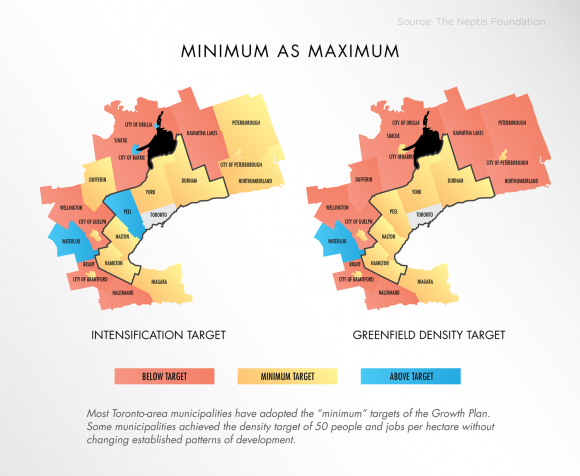Answers to questions of whether the land currently designated for development will last beyond 2031 and how much longer it will last depend on many different factors.
Neptis research into the Growth Plan addresses four areas that will have an impact on the land supply question and the question of whether we need to designate more land or not.
Amount of designated land urbanized since 2006
We know how much land was actually built on between 2006 and 2011 in the Greater Toronto and Hamilton Area (the Inner Ring). Similar information is not yet available for the Outer Ring.

Neptis researchers calculated the amount of designated urban land in the GTHA that was built between 2006 and 2011 is only 5,200 hectares or 9 percent of the 56,200 hectares of land already designated in the Inner Ring. Knowing how much land is being developed gives a clearer picture of how long the currently designated and available land supply will last.
Rate of land consumption (1991-2011)
The Growth Plan was created to reshape development relative to the trends that prevailed in the 1990s. However, even while policy makers were crafting the provisions of the Plan, those trends were changing
Recent Neptis research has shown that the rate at which new land was being urbanized (greenfield development) in the GTHA began slowing down after 2001.
Between 1991 and 2001, the population of the GTHA grew 19 percent, while the urban area expanded by 26 percent.
Between 2001 and 2011, the population of the GTHA grew by 18 percent, but the urban area expanded by only 10 percent.

This means that developers were already creating more compact communities, even before the Growth Plan. This finding raises questions about whether the Growth Plan could have been more ambitious with its targets for intensification and new development on greenfields.
The need for diversification of housing stock
Although the rate at which new land is being developed was declining even before the Growth Plan was established, the composition of the housing stock was not changing very much. Most of the new housing in the GTHA consists of single detached houses, despite the need for a variety of forms such as townhouses, semis, and midrises, which are usually more affordable for young families, newcomers, and those on modest incomes.
A recent TD report cites this imbalance as one reason why the GTHA has a housing affordability issue. This issue should be a focus of study during the review of the Growth Plan.

Neptis researchers compared Toronto's housing stock to that of Vancouver, because Vancouver has achieved considerable success in reducing its rate of land consumption and outward growth. What they found is that the GTHA's supply of single detached homes has remained stable between 1991 and 2011. By comparison, the amount of detached housing as a proportion of all housing is falling in Vancouver.
There were also differences in the number of attached homes, mid-rises and high-rise buildings that showed that the Toronto region's housing stock is less diverse than that in the Vancouver region.
By diversifying the housing stock to include a higher proportion of smaller and more affordable units (particularly in attached housing forms and midrise apartment blocks), the municipalities in the Greater Golden Horseshoe might be able to make the existing land supply last longer than originally forecast and increase affordability at the same time.
Change in intensification and greenfield density targets
A change in intensification and greenfield density targets could also make the land currently designated last longer.

In the 2013 report, Implementing the Growth Plan for the Greater Golden Horseshoe, Neptis researchers found that most municipalities did not plan to exceed the targets set out in the Growth Plan.
The 107,100 hectares set aside to accommodate the forecast increase in population (estimated at 3.7 million people by 2031), shows that in fact, sufficient land has been set aside to accommodate population and employment at average densities similar to those that are typical today. If those densities were to increase, the current land supply would last even longer.
The review also found that most municipalities have adopted the "minimum" intensification and greenfield density targets of the Plan. Very few municipalities have followed the encouragement in the Plan to exceed the targets. Moreover, some municipalities achieved the density target of 50 people-and-jobs-per-hectare target without changing established patterns of development.
